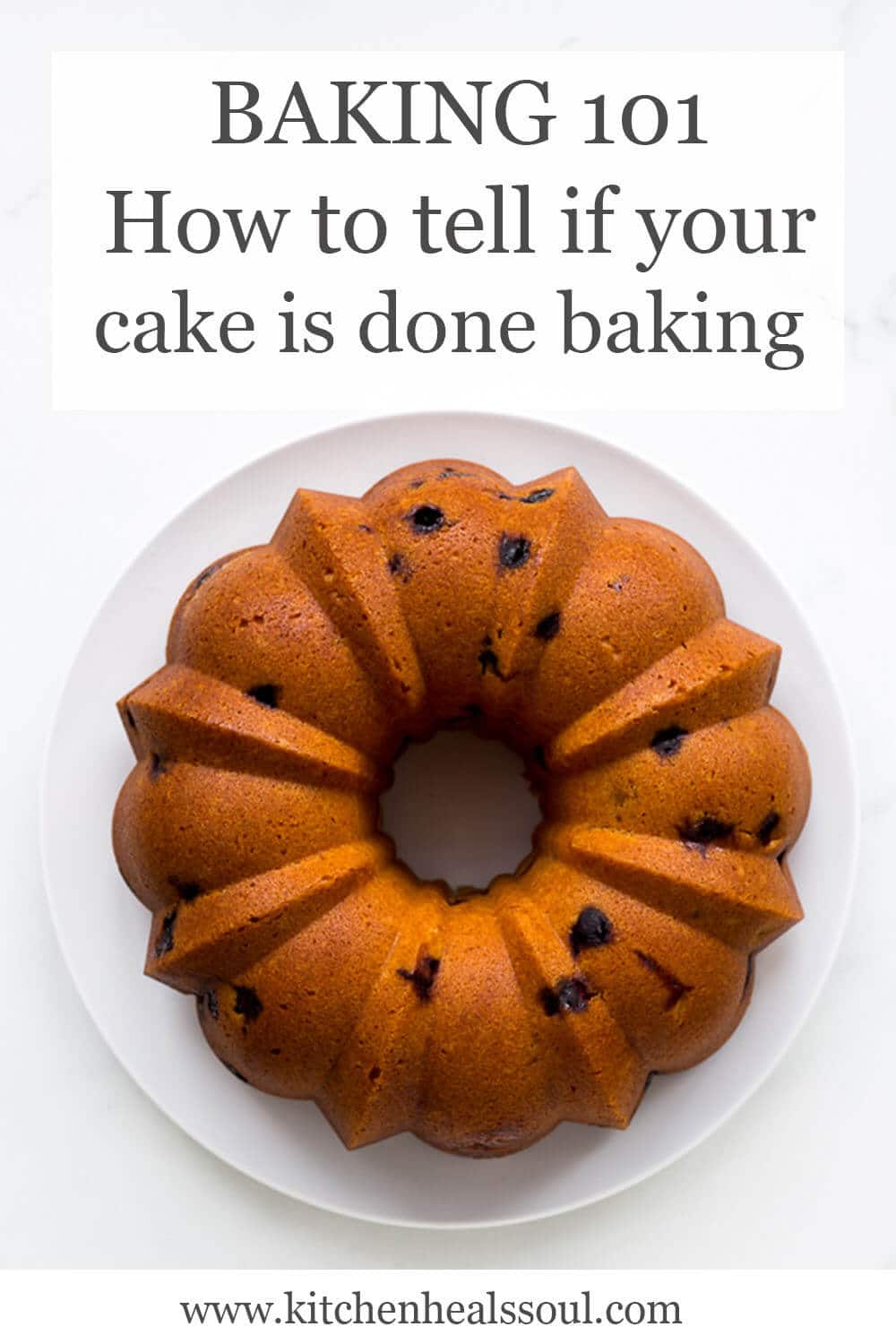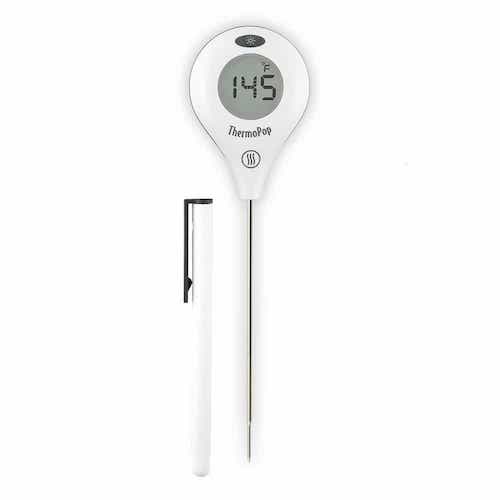One of the most challenging steps when baking a cake, or following any recipe, is figuring out whether it's done, under-baked, or over-baked. Here are all the methods you can use to check if your cake is done.

Ways to check if your cake is done
Use your timer (wisely)
While most recipes will indicate a baking time, you cannot only rely on time because most of us are baking with ovens that aren't calibrated. Your oven set to 350 ºF might run slightly hotter or colder than my oven set to 350 ºF. Our baking times for the same recipe won't be the same. Plus you are using different cake pans than I'm using. I might use a darker pan or an aluminum pan, while you might only have a glass pan at home.
Baking times are recommendations that are there to guide you, but take them with a grain of salt and make sure to check on what you're baking a few minutes before the timer goes off for cookies, and even 10 or 15 minutes before the timer goes off for loaf cakes and baked goods that you are anticipating may take an hour to bake.
Visually inspect the cake to see if it's done
Take the time to look at the cake and analyze what you see before you take it out of the oven. Ask yourself two things:
- is the cake pulling away from the sides cleanly all by itself? Can you see a very thin gap between the edges of the cake and the pan? It might be done! But use another method to be sure (cake tester, thermometer)
- are the edges of your cake golden brown? Regular round cakes that are an inch or two tall will take roughly 30 minutes to bake. Square cakes might take 40 minutes. In both cases, the edges should turn golden brown. On the other hand, a loaf cake will probably bake for at least an hour, in my experience, which means that the edges get quite brown, regardless of how much baking soda you use. For loaf cakes, the edges can be deceiving because they will brown a lot more than for layer cakes. Keep this in mind and don't panic if you see the edges of the loaf getting quite dark. Note for chocolate cakes, you obviously can't use the colour of the edges to judge doneness. But looking at the edges, you'll notice they aren't shiny anymore, but rather matte and look dry and set. Use a cake tester or a thermometer to be sure (see below).
Use your hands to check if the cake is baked
It's important to understand how the texture of a cake changes as it bakes. Cake batter is fairly thick at room temperature, especially if it's made with dense ingredients like mashed bananas or a lot of flour. When the cake pan hits the oven, the batter begins to warm and it becomes looser and more fluid initially. Then as the cake continues to bake, the crust begins to dry out and brown as the batter rises and sets. You can carefully use your fingertips to check how a cake is doing:
- does the cake bounce back when pressed gently with your finger tips? Press and tap the cake with your fingers. It should feel firm but bouncy. If you press the cake and remove your hand, but your fingers leave an indent or imprint, your cake is under-baked. Continue baking. If your cake is springy but firm, your cake might be done. Try another method to be sure (cake tester or thermometer)
Use a cake tester to see if the cake is baked through to the middle
If the visual and tactile clues aren't enough, a cake tester will help you decide if your cake is baked (or not). Many chefs like to insert a pairing knife into the centre to test the middle. I prefer using a metal cake tester like this one from Ateco on Amazon. Insert the cake tester in the middle of the loaf and push it through to the centre/towards the bottom. Remove the cake tester and analyze what you see:
- if it looks like cake batter's clung to the cake tester, your cake is still raw in the middle. Feel free to run your fingers over the cake tester to feel if it's come out with cake batter or if it comes out clean.
- if you just retrieved a few crumbs on the cake tester, your cake is on the verge of being baked through and it's probably safe to remove from the oven, assuming you've noted some of the other clues above.
- if the cake tester comes out clean, your cake is probably baked through
- if you have included ingredients like dried fruit or chocolate chips, if you poke through one of those, you can no longer be sure
Use a thermometer to see if the cake is baked through to the middle
A cake tester works very well, but you can also use a thermometer to check the internal temperature of your cake to see if it's baked in the middle. The internal temperature of cakes, like vanilla butter cake or banana bread without nuts, should be around 100 ºC (212 ºF).



I own a pink Thermapen which is very fast at registering temperatures and temperature changes. The Thermoworks ThermoPop is a great instant-read thermometer that would be handy to check if your cake is done baking, while the ChefAlarm is a probe thermometer more appropriate for candy making, like if you want to make maple butter or maple fudge where you need to a fast-reading thermometer to monitor temperature over a longer period of time. Honestly, you can use these interchangeably, but if you plan on making candy or checking the marmalade setting temperature, a probe thermometer with a longer cable like the ChefAlarm is essential so that you can leave the probe in the pot and keep your hands away from the hot sugar!
Other considerations for checking doneness
If your cake contains add-ins like candied or dried fruits, chocolate chips or chunks of chocolate, berries or chunks of fruit, using a cake tester alone to determine doneness is not ideal. For example, this white fruitcake recipe is full of yummy dried and candied fruit which makes it almost impossible to insert a cake tester without stabbing through a fruit. This means, the skewer almost always comes out clean, regardless of what's actually going on inside of the cake.
For cases like this, you have no choice but to combine the skewer test with other methods to make sure your cake is baked in the middle.
Signs your cake is underbaked
There's nothing sadder than cutting into a cake and finding it's raw in the middle. So, how can you tell if your cake needs more time in the oven?
- when you tap the cake gently with your fingertips, you leave a mark behind that doesn't puff back or spring back right away: this is a sure sign that the structure inside the cake, underneath the crust, hasn't set. Your cake is definitely underbaked and you should put it back in the oven to bake it more.
- a cake tester inserted in the middle comes out wet or covered in the cake batter. For brownies, many recipe writers recommend that you bake until a cake tester comes out with just a few crumbs clinging to it. If the cake tester comes out covered in batter, regardless of what you are baking, it's probably underbaked
- a thermometer inserted into the centre shows that the internal temperature of the cake is below 98 ºC (200 ºF): this is a sign that your cake needs more time in the oven for most cakes, especially butter cakes.
- if your cake collapses or sinks as it cools, it's probably underbaked: if the crumb of the cake hasn't dried out enough and set, there is a big risk that the cake will collapse as it cools. You may notice a gummy layer or even a gooey layer at the bottom too.
If your cake is under-baked, unfortunately, you can't just throw it back in the oven to fix the problem. This won't work and what will happen is the outside and crust of the cake will dry out and possibly even burn before the inside bakes through. Your best bet to salvage an overbaked cake cut it up into pieces, which will allow you to remove the parts that are raw. Take what's left of the cake scraps and turn them into Christmas trifle or cake truffles.
How to check if your cake is overbaked
If you have over-baked a cake, it's rather obvious in most cases. The cake will be dry and extra crumbly when sliced. If you notice your cake is crumbling or losing a lot of crumbs as you slice it, it's probably over-baked.
The outer edge will have a flavour that is verging on burnt, past the point of being considered caramelized if it's overcooked. You will even notice that the crumb on the inside will start to brown if you've really overdone it.
While a perfectly baked cake will pull away from the sides of the pan a little, revealing a thin gap around the edges, an overcooked cake will have pulled away even more from the pan, leaving a larger separation between the pan and the cake
If you've over-baked a cake, don't throw it out! You can use it to make a berry yogurt breakfast bowl: chop it up and serve it over yogurt with berries, or use it in a apricot trifle, being sure to soak the cake layers with extra syrup (or sherry). You could also turn the scraps into birthday cake truffles.






Leave a Reply